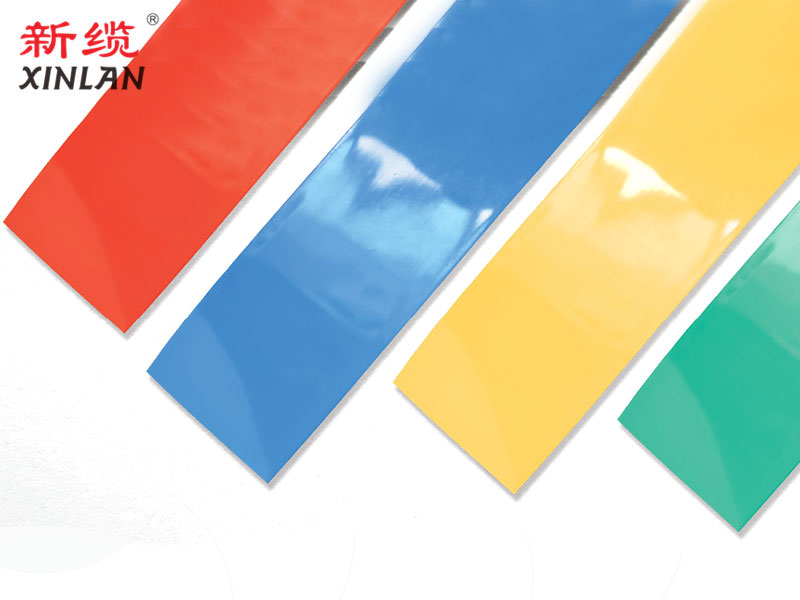Heat shrinkable tubing
Position:Home > Products > Heat shrinkable tubingHeat-Shrinkable PVC Tubes
- Specification
- Description
- Download

| Specification | Folded diameter | Wall thickness | Portrait shrinkable rate at 100℃ | Portrait shrinkable rate at high temperature | ||
| mm | mm | 85℃ | 108℃ | 85℃ | 105℃ | 180℃ &15 minutes |
| φ2.8 | 4.7±0.5 | 0.08±0.015 | 0.08±0.015 | 9±2 | 7±2 | ≤20±3 |
| φ3 | 5.0±0.5 | 0.08±0.015 | 0.08±0.015 | 9±2 | 7±2 | ≤20±3 |
| φ3.2 | 5.5±0.5 | 0.08±0.015 | 0.08±0.015 | 9±2 | 7±2 | ≤20±3 |
| φ4 | 7.0±0.5 | 0.08±0.015 | 0.08±0.015 | 9±2 | 7±2 | ≤20±3 |
| φ5 | 8.7±0.5 | 0.08±0.015 | 0.08±0.015 | 9±2 | 7±2 | ≤20±3 |
| φ6 | 10.5±0.5 | 0.08±0.015 | 0.08±0.015 | 9±2 | 7±2 | ≤20±3 |
| φ7 | 12.0±1 | 0.08±0.015 | 0.08±0.015 | 9±2 | 7±2 | ≤26±3 |
| φ8 | 13.8±1 | 0.08±0.015 | 0.08±0.015 | 9±2 | 7±2 | ≤26±3 |
| φ9 | 15.0±1 | 0.08±0.015 | 0.08±0.015 | 9±2 | 7±2 | ≤26±3 |
| φ10 | 16.8±1 | 0.10±0.02 | 0.10±0.02 | 9±2 | 7±2 | ≤26±3 |
| φ11 | 18.0±1 | 0.10±0.02 | 0.10±0.02 | 9±2 | 7±2 | ≤26±3 |
| φ12 | 20.0±1 | 0.10±0.02 | 0.10±0.02 | 9±2 | 7±2 | ≤26±3 |
| φ13 | 21.5±1 | 0.10±0.02 | 0.10±0.02 | 9±2 | 7±2 | ≤26±3 |
| φ14 | 23.5±1 | 0.10±0.02 | 0.10±0.02 | 9±2 | 7±2 | ≤26±3 |
| φ15 | 24.5±1 | 0.10±0.02 | 0.10±0.02 | 9±2 | 7±2 | ≤26±3 |
| φ16 | 27.0±1 | 0.10±0.02 | 0.10±0.02 | 9±2 | 7±2 | ≤26±3 |
| φ17 | 28.0±1 | 0.10±0.02 | 0.10±0.02 | 9±2 | 7±2 | ≤26±3 |
| φ18 | 29.0±1 | 0.10±0.02 | 0.10±0.02 | 9±2 | 7±2 | ≤26±3 |
| φ19 | 31.0±1 | 0.10±0.02 | 0.10±0.02 | 9±2 | 7±2 | ≤26±3 |
| φ20 | 32.5±1 | 0.10±0.02 | 0.10±0.02 | 9±2 | 7±2 | ≤26±3 |
| φ21 | 34.0±1 | 0.12±0.02 | 0.12±0.02 | 9±2 | 7±2 | ≤26±3 |
| φ22 | 35.5±1 | 0.12±0.02 | 0.12±0.02 | 9±2 | 7±2 | ≤26±3 |
| φ23 | 36.5±1 | 0.12±0.02 | 0.12±0.02 | 9±2 | 7±2 | ≤26±3 |
| φ24 | 39.0±1 | 0.12±0.02 | 0.12±0.02 | 9±2 | 7±2 | ≤26±3 |
| φ25 | 41.0±1.5 | 0.12±0.02 | 0.12±0.02 | 9±2 | 9±2 | ≤27±3 |
| φ26 | 43.5±1.5 | 0.12±0.02 | 0.12±0.02 | 9±2 | 9±2 | ≤27±3 |
| φ27 | 45.0±1.5 | 0.12±0.02 | 0.12±0.02 | 9±2 | 9±2 | ≤27±3 |
| φ28 | 46.5±1.5 | 0.12±0.02 | 0.12±0.02 | 9±2 | 9±2 | ≤27±3 |
| φ30 | 50.0±1.5 | 0.15±0.025 | 0.15±0.025 | 9±2 | 9±2 | ≤27±3 |
Product description:
1.85℃ 105℃125℃ UL PVC material
2.Operating temperature:-40℃~50℃
3.Flame retardant UL224 VW-1
4.Excellent insulation
5.Good flexibility
6.Resistance to acid & oil
7.Hook up wire & lead wire production
Application:
For general insulation and production for appliance, wire harness, transformer, lead wire of motors, etc.


